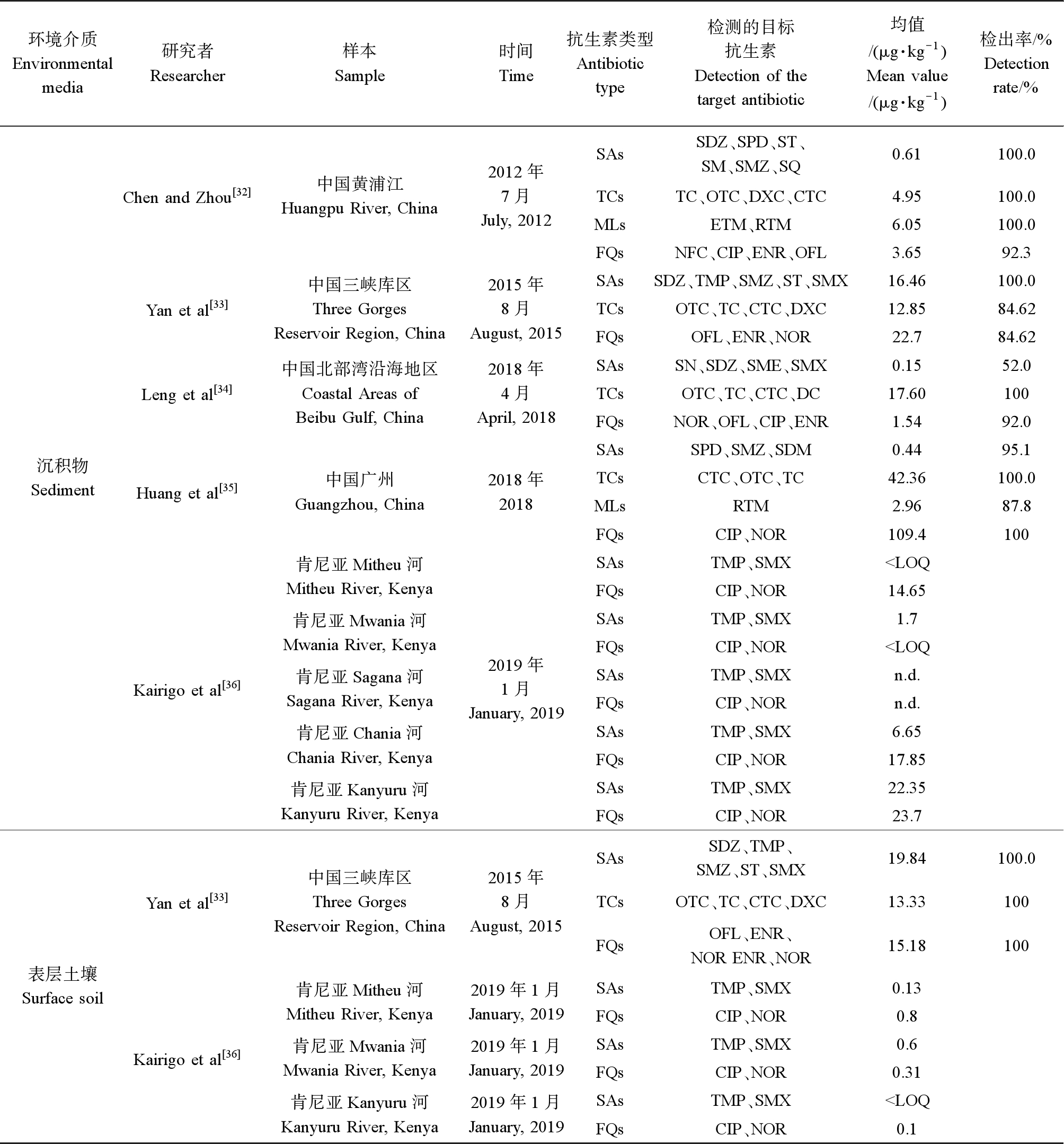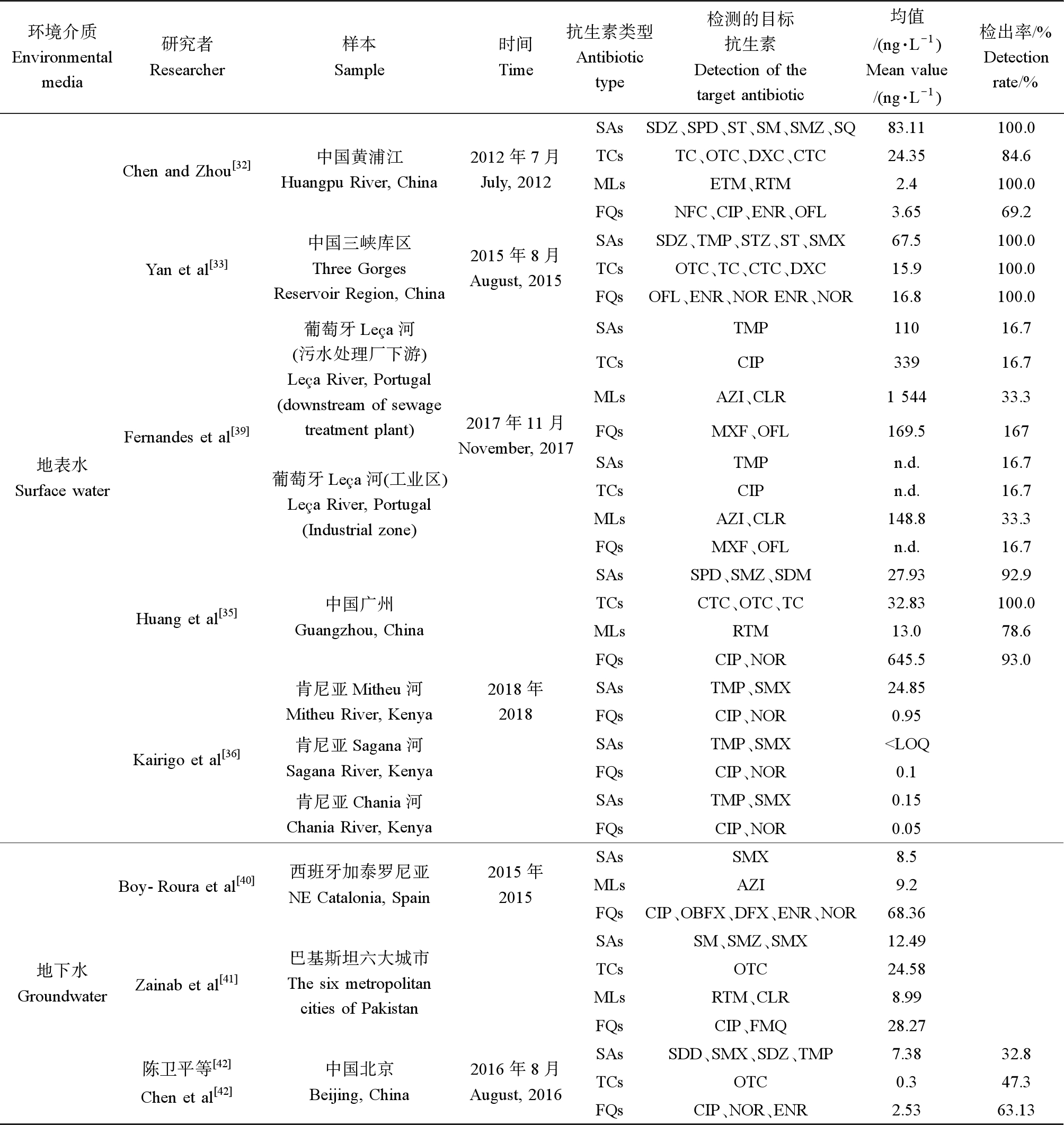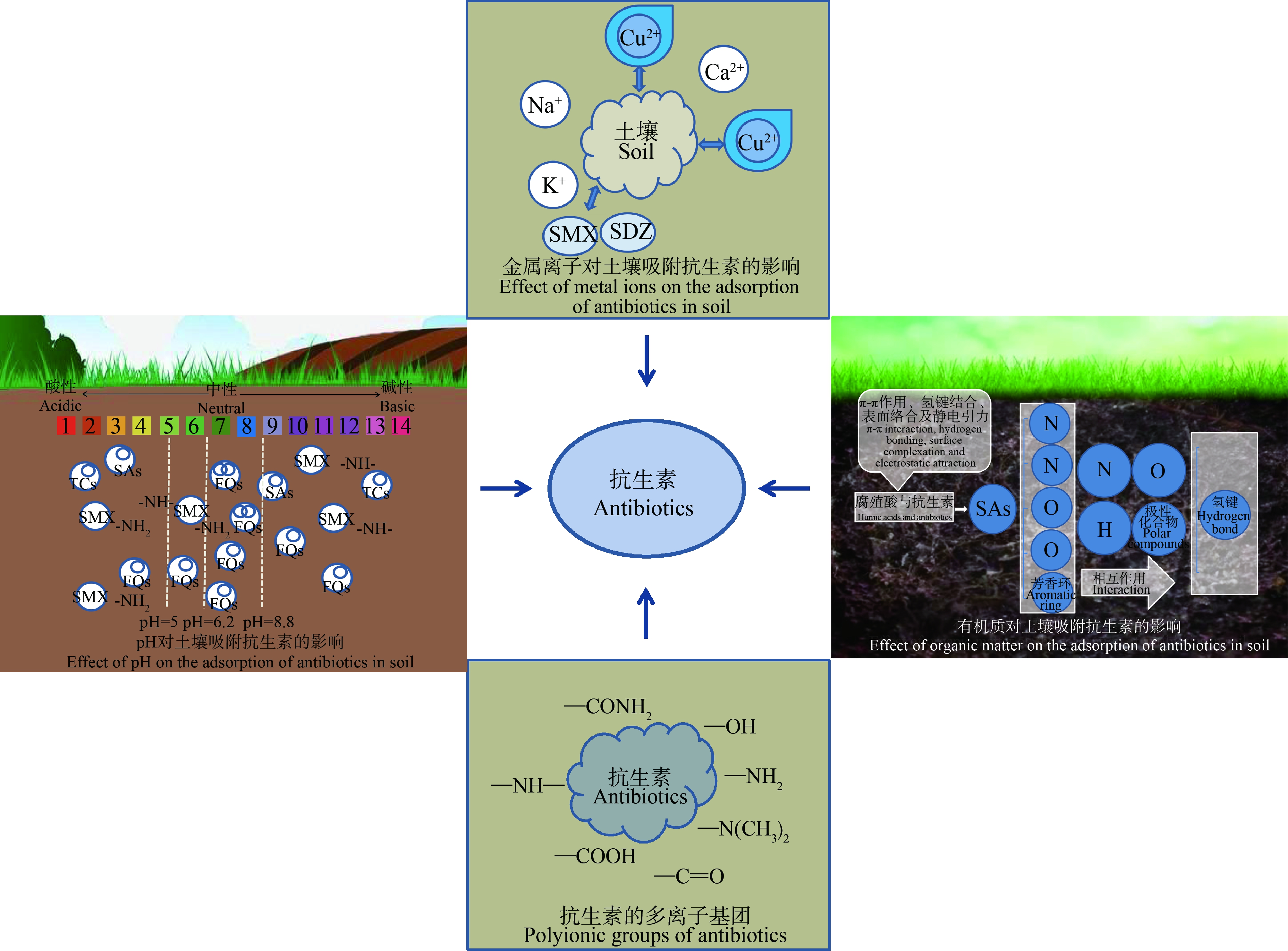抗生素是由微生物通过二次代谢自然合成或者从工业中人工合成的有机物质,能抑制其他微生物的生长或代谢活性甚至使其代谢、死亡[1]。抗生素经过废水处理、农业灌溉和污泥处理后排放到土壤中,不断累积[2-3]。且此类药物在畜禽养殖过程中具有使用量大、机体利用率低、降解周期长的特点,在自然环境中残留风险大。水和土壤是自然环境中不可或缺的因素。其中,地表水和地下水是水环境的重要组成部分。土壤环境一般指地球陆地表面的土壤圈层。沉积物与土壤指代的范围不同,但沉积物可向土壤演化,所以以下将沉积物相关内容划到土壤环境进行论述。
近年来,在水和土壤环境中频繁检测到抗生素。在2005—2016年期间,中国的7条主要河流和4个海域的水体和沉积物样本中共检测出94种抗生素,抗生素的残留给人类和生态环境带来了巨大威胁[4]。其中,磺胺类(sulfonamides,SAs)、四环素类(tetracyclines,TCs)、大环内酯类(macrolides,MLs)和氟喹诺酮类(fluoroquinolones,FQs)是中国消费量最大的四大类抗生素,常用于畜牧养殖以及临床医疗,在水-土壤环境中经常被检测到[5-6]。对位于我国北部的白洋淀进行调查,研究抗生素在其水体、沉积物和生物群中的存在和分布情况可知,SAs在水中浓度为0.86~1 563 ng·L-1,是水中的主要抗生素;FQs在沉积物和水生植物中浓度较高,含量分别为65.5~1 166 μg·kg-1和8.37~6 532 μg·kg-1;FQs和MLs在水生动物和鸟类中检出频率较高,含量分别为17.8~167 μg·kg-1和低于检测限值至182 μg·kg-1[7]。对位于我国南部的珠江口进行调查,分析位于珠江口的珠海市河流和沿岸水体及沉积物样品中的抗生素,发现诺氟沙星、大观霉素和硫酸链霉素在水体和沉积物中的浓度较高,分别为32.8~537 ng·L-1和2.48~444 ng·g-1,检出率较高,为100%;珠江三角洲海水养殖区收集的水样中检测出磺胺甲噁唑(SMX)、甲氧苄啶(TMP)、中氟哌酸(NFX)、氟嗪酸(OFX)、环磷酰胺(CTX)和链霉素(STM)等6种抗生素,各采样点的CTX水平较低,但其检出率高达100%,SMX、TMP和NXF的检出率约为50%[8-9]。地表水中的抗生素通过侧向补给进入地下水和土壤,在水-土壤环境中迁移[10]。尽管经过处理后进入环境中的抗生素浓度很低,但少量、持续的排放仍会对人类健康和生态环境造成威胁。人类或兽类多种类、多剂量地使用抗生素会造成城市水系统中相关抗生素抗性基因的严重污染,威胁到城市用水安全和水环境的生态安全[11]。抗生素在水和沉积物中的残留可能会对食物链造成潜在风险,包括抑制土壤分解的能力、对水生生物造成影响,促进细菌抗性基因的发展等[12-13]。我国高度重视水-土壤环境中的抗生素污染问题,农业农村部发布一系列针对滥用抗生素专项整治的公告,污染控制已刻不容缓。
近年来,许多学者对抗生素在水体、沉积物和土壤中的分布情况进行了研究。但是,关于水-土壤环境大体系中的抗生素研究相对较少。随着社会的发展,抗生素的检测技术和环境风险分析手段都得到了提高,这有利于研究抗生素在环境中的归趋问题。因此,有必要回顾、归纳、总结近年来该领域的文献。本文主要论述了水-土壤环境中抗生素的来源、使用现状和污染现状,对水-土壤环境中抗生素的吸附行为进行了分析,重点讨论了金属离子、pH、有机质和分子结构对抗生素吸附的影响机理。
1 水-土壤环境中的抗生素(Antibiotics in the water-soil environment)
1.1 来源(Source)
由于抗生素功效显著,其被广泛应用于临床医疗、畜牧养殖、水产养殖和其他农业生产活动,使得其生产和消费快速增长[14]。水-土壤环境中抗生素的主要来源有以下几个方面。
(1)医用。据世界卫生组织调查,我国住院患者抗生素药物使用率高达80%,医用抗生素是目前抗生素的最主要污染源之一[15]。医用抗生素主要通过以下方式进入水-土壤环境:在生物体中未能被吸收而伴随着粪便和尿液被排入环境;含有抗生素的医疗废物以及医疗器械未被合理处置;药物科研机构以及生产机构生产废水的排放[16]。
(2)畜禽养殖业。与居住区和工业区不同,流域的农业区是河流中抗生素污染的主要来源[17-18]。为了预防和治疗动物疾病以提高生长生产效率,抗生素被广泛应用于畜牧业和水产养殖业,这也是环境中重要污染来源之一[19]。畜禽养殖业中抗生素的长期使用不仅会导致抗生素残留在水-土壤环境中,还会产生耐药基因,而由于耐药基因的影响,农户会加大抗生素药物的使用量以及延长使用周期,这会导致更多的抗生素被残留在环境中。
(3)污水/废水。生物体只能吸收小部分抗生素,大多数用于人类和畜禽的抗生素会通过生物体以粪便和尿液的形式进入到污水处理厂或者直接进入水环境、土壤环境。现有的污水处理技术难以完全去除污水中的抗生素,大部分抗生素将被排入水环境中,地表水与地下水都将受到污染[14,19]。
1.2 使用现状(Status of use)
2013年抗生素在中国总使用量为162 000 t,其中用于人类自身的占总使用量的48%[5]。在中国,约有97 000t抗生素用于养殖业,为年总产量的46.1%,SAs、TCs、FQs、MLs和β-内酰胺类等五大类抗生素在华东地区消耗量最大,西北地区消耗量最小[20-21]。中国与美国SAs和TCs抗生素的使用量相当,但高于意大利和法国等欧洲国家,中国的人均抗生素用量更高,例如,德国(2001年)、波兰(2000年)、西班牙(2003年)、瑞典(2005年)和瑞士(2000年)罗红霉素的人均使用量分别为75.2、53.0、9.3、1.6和20.4 mg,而中国(2000年)的人均使用量高达135 mg[20-21]。在美国、欧洲和亚洲的部分地区,兽用抗生素普遍使用以及施用化肥等农业行为促使抗生素出现在地下水中[22-23]。
随着社会的发展,抗生素的使用量不断增加。2000年,低收入、中等收入以及高收入的国家抗生素消费量类似;2015年,低收入和中等收入国家抗生素消费总量是高收入国家抗生素消费总量的2.5倍,预计在2030年包含抗生素在内的抗菌药年总使用量将达到236 757 t[24-25]。从抗菌药物的限定日剂量(DDDs)来看,全球抗生素消费量在2000—2015年间从211亿DDDs增长到348亿DDDs,提高了65%,其中,印度从32亿DDDs增长到65亿DDDs,提高了103%;中国从23亿DDDs增长到42亿DDDs,提高了79%;巴基斯坦从8亿DDDs增长到13亿DDDs,提高了65%[25]。
根据抗生素的污染情况,各国针对抗生素规范使用制定了相应的法律法规。2003年9月22日,欧洲议会和理事会关于动物营养添加剂的(EC)第1831/2003号条例规定,2006年起禁止将抗生素作为饲料添加剂使用[26]。澳大利亚对喹诺酮类药物使用进行限制[27],美国2014年起禁止使用促生长类抗生素,2017年起禁止使用预防类兽用抗生素[28]。中国农业农村部2018年启动实施兽用抗菌药使用减量化行动;2020年发布第194号和246号公告,实施药物饲料添加剂退出行动,中国饲料中全面禁止添加抗生素;2021年发布的1号文件中做出了在2021—2023年对水产养殖用兽药、饲料和饲料添加剂相关违法行为进行专项整治的决定。
1.3 污染现状(Pollution situation)
抗生素进入土壤后,易发生微生物转化、光降解、地表径流、淋溶、植物吸收、吸附/解吸或固存,从而导致抗生素在水-土壤环境中迁移[29]。抗生素中存在的一个或多个如氨基、羟基或羰基等亲水性极性官能团,易与水结合形成水合物,而加速抗生素从包气带土壤向地下水的渗透[30]。沉积物作为抗生素在水环境中的“储存库”,水环境中的抗生素可通过分配作用进入沉积物,也可在环境条件改变时重新释放进入水体[31]。
在2012—2019年期间,对中国的黄浦江、三峡库区、北部湾沿海地区、广州和北京,并对葡萄牙、肯尼亚、西班牙和巴基斯坦等其他国家进行抗生素污染调查,采样后测定土壤、沉积物、地表水和地下水中不同抗生素的浓度,结果如表1和表2所示。
表1 土壤环境中抗生素的浓度
Table 1 Concentrations of antibiotics in soil environment

环境介质Environmental media研究者Researcher样本Sample时间Time抗生素类型Antibiotic type检测的目标抗生素Detection of the target antibiotic均值/(μg·kg-1)Mean value/(μg·kg-1)检出率/%Detection rate/%沉积物SedimentChen and Zhou[32]Yan et al[33]Leng et al[34]Huang et al[35]Kairigo et al[36]中国黄浦江Huangpu River, China中国三峡库区Three Gorges Reservoir Region, China中国北部湾沿海地区Coastal Areas of Beibu Gulf, China中国广州Guangzhou, China肯尼亚Mitheu河Mitheu River, Kenya肯尼亚Mwania河Mwania River, Kenya肯尼亚Sagana河Sagana River, Kenya肯尼亚Chania河Chania River, Kenya肯尼亚Kanyuru河Kanyuru River, Kenya2012年7月July, 20122015年8月August, 20152018年4月April, 20182018年20182019年1月January, 2019SAsSDZ、SPD、ST、SM、SMZ、SQ0.61100.0TCsTC、OTC、DXC、CTC4.95100.0MLsETM、RTM6.05100.0FQsNFC、CIP、ENR、OFL3.6592.3SAsSDZ、TMP、SMZ、ST、SMX16.46100.0TCsOTC、TC、CTC、DXC12.8584.62FQsOFL、ENR、NOR22.784.62SAsSN、SDZ、SME、SMX0.1552.0TCsOTC、TC、CTC、DC17.60100FQsNOR、OFL、CIP、ENR1.5492.0SAsSPD、SMZ、SDM0.4495.1TCsCTC、OTC、TC42.36100.0MLsRTM2.9687.8FQsCIP、NOR109.4100SAsTMP、SMX 注:n.d.表示未检测到或低于检出限;
表2 水环境中抗生素的浓度
Table 2 Concentrations of antibiotics in water environment

环境介质Environmental media研究者Researcher样本Sample时间Time抗生素类型Antibiotic type检测的目标抗生素Detection of the target antibiotic均值/(ng·L-1)Mean value/(ng·L-1)检出率/%Detection rate/%地表水Surface waterChen and Zhou[32]Yan et al[33]Fernandes et al[39]Huang et al[35]Kairigo et al[36]中国黄浦江Huangpu River, China中国三峡库区Three Gorges Reservoir Region, China葡萄牙Leça河(污水处理厂下游)Leça River, Portugal (downstream of sewage treatment plant)葡萄牙Leça河(工业区)Leça River, Portugal (Industrial zone)中国广州Guangzhou, China肯尼亚Mitheu河Mitheu River, Kenya肯尼亚Sagana河Sagana River, Kenya肯尼亚Chania河Chania River, Kenya2012年7月July, 20122015年8月August, 20152017年11月November, 20172018年2018SAsSDZ、SPD、ST、SM、SMZ、SQ83.11100.0TCsTC、OTC、DXC、CTC24.3584.6MLsETM、RTM2.4100.0FQsNFC、CIP、ENR、OFL3.6569.2SAsSDZ、TMP、STZ、ST、SMX67.5100.0TCsOTC、TC、CTC、DXC15.9100.0FQsOFL、ENR、NOR ENR、NOR16.8100.0SAsTMP11016.7TCsCIP33916.7MLsAZI、CLR1 54433.3FQsMXF、OFL169.5167SAsTMPn.d.16.7TCsCIPn.d.16.7MLsAZI、CLR148.833.3FQsMXF、OFLn.d.16.7SAsSPD、SMZ、SDM27.9392.9TCsCTC、OTC、TC32.83100.0MLsRTM13.078.6FQsCIP、NOR645.593.0SAsTMP、SMX24.85FQsCIP、NOR0.95SAsTMP、SMX 注:n.d.表示未检测到或低于检出限;
在土壤环境中,沉积物和表层土壤是抗生素重要储存场所之一。沉积物和表层土壤是2种不同但可以相互转化的环境介质。表层土壤在水的冲刷作用下进入自然水体后形成沉积物中的一部分,而沉积物被露出水面经人工或自然作用后又可形成土壤。
沉积物体系复杂,含有粘土矿物、金属氧化物和有机质等多种组分,是抗生素在水体中迁移吸附的重要环境介质[37]。沉积物对各类抗生素有不同程度的吸附能力,浓度均在μg·kg-1级别。在黄浦江沉积物中检出的单类抗生素浓度均值范围为0.61~6.05 μg·kg-1,含量较低但检出率较高;在三峡水库沉积物中检出的单类抗生素浓度均值范围为12.85~22.7 μg·kg-1,含量与检出率都比黄浦江的样本高,这可能与城市化水平有关;在北部湾沉积物中检出的单类抗生素浓度均值范围为0.15~17.60 μg·kg-1,其中TCs含量最高,这可能是因为北部湾海域养殖业发达,广泛使用TCs兽药;在广州内陆河流沉积物中检出的单类抗生素浓度均值范围为0.66~42.36 μg·kg-1,TCs和FQs含量远高于SAs和MLs,这可能与饮食习惯以及城市化水平有关,其中TCs和FQs被广泛用于养殖业,在禽肉类产品中多有残留[38]。
在肯尼亚3个地区的4条河流沉积物中检出的单类抗生素浓度均值范围为n.d.~23.7 μg·kg-1,其中多种抗生素未检出。不同国家不同地区沉积物中检测出来的抗生素残留程度相差较大,这与当地的城市发展水平以及抗生素使用习惯有一定的关系。
随着畜禽养殖业的发展,抗生素通过不同途径源源不断进入到土壤,残留在土壤中的抗生素不断迁移、转化和累积。中国是一个农业大国,从表层土壤中抗生素检出率以及含量上可以发现,农业生产过程中使用的抗生素会残留在土壤中。不同国家、地区抗生素残留水平不同,肯尼亚表层土壤中抗生素的含量极低,而我国三峡库区表层土壤中检出的TCs、SAs和FQs含量远高于肯尼亚几个地区的表层土壤的抗生素含量。导致这种结果的原因可能是畜禽种类、抗生素使用习惯以及环境差异等。
随着抗生素使用量与排放量的提高,水环境中的抗生素不断积累。国内外地表水存在不同程度抗生素污染,水中抗生素的残留水平是由多种因素造成的,包括抗生素的消费模式、污水处理厂的规模和不同的处理技术。不平衡的区域发展也致抗生素残留水平空间分布存在明显差异。我国黄浦江和三峡水库以及广州几个河流抗生素残留量略高,污染水平远高于葡萄牙和肯尼亚;肯尼亚几个地区各类抗生素污染水平极低,除SAs类略高外,其他抗生素几乎都未检出。SAs是在地表水中检出浓度以及检出率相对较高的一种抗生素。
地下水是人类日常生产生活中必不可少的资源。相对于地表水来说,地下水存储在地下含水层中,不易受到直接的污染。事实上,在地下水中发现了包括抗生素在内的许多污染物,在上述这几个地区和国家,西班牙未检出TCs,我国北京未检出MLs,巴基斯坦TCs、SAs、MLs和FQs均有检出,单类抗生素浓度均值范围在0.3~68.36 ng·L-1之间,这表明地下水是水环境中潜在的抗生素储备库。对比不同地区地下水中抗生素残留情况,发现地下水中残留的抗生素种类较多,但不同地区同种类抗生素浓度不同,成分分布存在明显地区差异,可能与该地区抗生素的消费水平有关,如FQs和SAs分别是我国北方和南方地区的主要抗菌药物。抗生素在地下水中的发生和分布等环境行为一定程度上反映了当地的人类行为。
通过样本比对可知,在土壤环境中,MLs的残留浓度在2.96~6.05 μg·kg-1之间,残留水平最低;FQs的残留浓度在n.d.~109.4 μg·kg-1,残留水平最高,但MLs与FQs残留浓度的中位数相当;此外,SAs的残留浓度与中位数均比TCs的小。在水环境中,这几类抗生素残留浓度从低到高分别为SAs
对比几大类抗生素在水环境和土壤环境中的残留水平不难发现:SAs在水环境和土壤环境中均有残留且更容易在水环境中残留,原因可能是其具有良好的化学稳定性和环境迁移能力,不易被降解。TCs具有良好的水溶性、光解特性和较高的辛醇-水分配系数(Kow),容易被沉积物或土壤吸附。TCs的亲水性和低挥发性决定了其在水环境中具有显著的持久性,稳定的化学性质使其在环境中长期存在、累积以及扩散[43-44]。FQs自身性质稳定,半衰期长,比其他类抗生素具有更强的土壤蓄积能力和持久性,在水环境中被频繁检出,排入水-土壤环境中的FQs主要通过光解降解,受水中溶解性物质、pH以及光敏剂等因素影响,降解慢[45-47]。MLs在水环境中具有较高的生物可降解性,吸附到沉积物中之后很难迁移到深层沉积物中,可能是因其具有较高的衰减速率[48-49]。
2 水-土壤环境中抗生素的吸附行为(Adsorption behavior of antibiotics in the water-soil environment)
2.1 抗生素的吸附行为(Adsorption behavior of antibiotics)
使用后未被吸收的抗生素通常会以未经转化的原始形式进入到水和土壤环境中,部分亲和力较强的抗生素可被稳定吸附在土壤颗粒表面,而较难被吸附在土壤上的抗生素容易在渗透作用或地表径流的作用下进入水环境中[31,50]。
SAs、TCs、MLs和FQs等典型抗生素在不同介质中存在不同的吸附特性。SAs属于亲水性物质,吸附势较低,在土壤中具有很高的流动性,施入土壤后会迅速迁移,最终进入地表水和地下水中[51-52]。TCs属于疏水性有机物,除进行离子交换外,还通过包括金属架桥与cation-π作用在内的表面络合机制在活性污泥上进行吸附[53]。MLs多为碱性亲脂性化合物,吸附能力较弱,易通过渗滤作用进入水环境[54-55]。FQs是具有强配位体氟原子、羰基、氨基以及离子交换羧基的两性化合物,能以不同方式与土壤相互作用,在土壤中具有较强的吸附能力[56]。
2.2 抗生素吸附行为的影响因素(Factors influencing antibiotic adsorption behavior)
分子结构、疏水性、极性、极化率和空间结构等抗生素的性质和土壤类型、土壤pH、共存离子、土壤有机质和土壤中存在的金属离子等土壤的基本性质对抗生素在土壤中的吸附行为有很大影响,在吸附过程中直接或间接影响其在土壤中的降解和生物利用度[57-58]。其中,金属离子、pH、有机质和抗生素分子结构是土壤吸附抗生素的基本影响因素,以下将从这4个方面对其进行分析,其对土壤中抗生素吸附行为的影响如图1所示。

图1 金属离子、pH、有机质和抗生素分子结构对土壤吸附抗生素的影响
Fig. 1 Effects of metal ions,pH,organic matter and molecular structure of antibiotics on the adsorption of antibiotics in soil
2.2.1 金属离子对土壤吸附抗生素的影响(Effect of metal ions on the adsorption of antibiotics in soil)
抗生素是具有多个可电离的官能团的极性化合物。重金属可以催化抗生素的氧化,起到络合剂的作用,导致自由态的金属离子和抗生素减少,使抗生素保留在土壤中[2,59]。与抗生素不同,重金属不会被降解,只会长期存在于环境中。金属离子可能会抑制或增强抗生素在土壤中的吸附。多价金属离子和抗生素之间存在相同官能团的竞争,或通过阳离子的水化层干扰,或屏蔽吸附剂中的疏水和亲水位点,从而抑制抗生素的吸附[60-61]。金属离子可以通过阳离子-抗生素络合、静电吸引和外球络合增加抗生素的吸附[62-64]。
Cu和Zn会改变抗生素的吸附位点,导致土壤中抗生素含量受到影响,Cu和Zn的存在会增加土壤对四环素的吸附量[65-67]。Cu2+的水化反应强烈,会与水分子络合形成致密水化层,从而与有机物直接竞争吸附剂表面积,使有机污染物的吸附能力降低[68]。有研究表明,Cu2+在土壤中发生的水化反应强烈,Cu2+离子被水分子包围后寄生在致密水的水化层中,与磺胺甲噁唑和磺胺嘧啶争夺土壤疏水吸附区,从而抑制其在土壤上的吸附[69]。在pH>5.62时的吸附过程中,磺胺甲噁唑的负电荷被中和后与Cu2+形成络合物,中性和阳离子分子含量增加,带正电的磺胺甲噁唑和Cu2+竞争同一带负电的吸附部位,使磺胺甲噁唑的吸附能力提高[69]。粘土对阳离子物质有很高的吸附亲和力,土壤中存在的金属离子如Na+、K+和Ca2+等通过竞争性相互作用,对TCs在蒙脱石和高岭石等粘土矿物上的吸附产生负面影响[70-71]。离子强度较高时,随着盐浓度的增加,磺胺异噁唑溶解度会降低,土壤对磺胺异噁唑的吸附变大[72]。离子强度增加后土壤表面的质子和Al3+被Ca2+取代,pH略有下降,带负电荷的磺胺异噁唑向中性形式移动,这种中性形式比阴离子形式吸附得更强烈[72]。
2.2.2 pH对土壤吸附抗生素的影响(Effect of pH on the adsorption of antibiotics in soil)
抗生素在不同pH下呈现不同状态。在土壤等天然吸附剂中,SAs会以阳离子、阴离子或中性形式出现。如磺胺甲噁唑带有呈碱性的氨基(—NH2)和呈酸性的亚氨基(—NH—)使其具有2个解离常数(pKa),在不同pH值下能够以阳离子、两性离子和阴离子的形态存在[73-74]。pH值高于5.0时,SAs的阴离子会与土壤成分的负电荷发生强烈的静电斥力而导致吸附量减少;pH值较低时,SAs以阳离子形式与土壤中的阳离子交换,导致土壤对SAs的吸附增强[72]。随着pH值的增加,SAs从阳离子形态向中性和阴离子形态转变,带正电荷和中性电荷的SAs离子与表面带负电荷的土壤矿物静电结合[75]。pH小于第二离解常数时,SAs的非离子化性质决定了其吸附行为的主要机制是疏水分配[76]。
FQs是既含有酸性基团又含有碱性基团的双质子分子,可能以阳离子、两性离子、中性和阴离子的形式存在于环境中[77]。FQs的羧基和氨基上的正负表面电位将FQs电荷定位为两性离子或中性形式,从而影响FQs的溶解性和吸附,如FQs以中性形式出现时,在水和其他极性溶剂中较难溶;以两性离子形式出现时,在极性溶剂中更易溶[77-80]。FQs在不同pH溶液中的存在形式大致相同,都具有羧基(—COOH)和哌嗪基团2个质子结合位点,有2个pKa值分别为6.2和8.8,当pH
TCs具有三羰基酰胺、酚二酮和二甲胺3个质子结合位点、具有3个pKa值。当pH
具有碱性叔胺结构的MLs富含氨基或羟基,是弱碱类抗生素。此类抗生素易受pH的影响,如罗红霉素(RTM)具有氨基这一质子结合位点,pKa值为8.8,当pH<8.8时,反应性降低[86-87]。
2.2.3 有机质对土壤吸附抗生素的影响(Effect of organic matter on the adsorption of antibiotics in soil)
通过动植物残渣的不完全分解和降解后经过一系列化学过程而产生的腐殖酸,广泛分布于土壤、水和水沉积物中,是自然界中有机物的主要成分,也是环境污染物重要的络合剂、吸附剂或氧化还原剂[88-94]。
腐殖质以腐殖酸为代表,当抗生素接触到腐殖酸上具有的苯环骨架和丰富的含氧官能团时,可以以共存形式构成多介质体系,使迁移转化形势变得复杂。水环境中的腐殖酸来源可分为:通过植物、微生物在水体本身进行腐烂的内部来源和土壤、动植物的有机物残留物被微生物分解后进入水环境中的外部来源[95-97]。腐殖酸对抗生素的吸附主要涉及π-π作用、氢键结合、表面络合和静电引力等机制,范德华力、孔洞填塞和表面沉积等物理性质会促进其吸附作用[98]。
SAs对土壤的吸附,受土壤有机质含量及其在不同粒级之间的不均匀性即土壤有机质组成的影响[99]。如,腐殖酸高程度暴露且凹凸不平的表面、颗粒间松散结合的形态特征和多孔结构为以菌胶团为主的微生物菌群提供了栖息场所,这促进了磺胺甲噁唑的吸附[88,98]。在与土壤有机质分子体系的相互作用中,SAs上的2N原子、2O原子和1个芳香环等5个带负电荷的物质(相互作用中心上带电的N、O和H原子)与极性化合物相互作用后形成1个或2个氢键,芳香环上的电子密度与非极性化合物相互作用;非极性相互作用中心以分散相互作用为主;结合强度会随着土壤供水量的增加而降低[99]。其他抗生素如四环素,其极性官能团和腐殖质官能团的带电官能团之间同时相互作用会导致腐殖质对四环素的高吸附[100]。
2.2.4 分子结构对土壤吸附抗生素的影响(Effect of molecular structure on the adsorption of antibiotics in soil)
抗生素主要通过范德华力、氢键作用等分子间作用力与土壤颗粒表面的吸附位点结合,土壤中有机质等物质可以与抗生素分子中的醛、羧基和氢键等官能团发生吸附或者络合反应从而导致抗生素的微生物生长抑制潜力下降[98,101-102]。其中,抗生素的分子结构决定了它们的疏水性、极性、极化率和空间结构等物理化学性质,其分子结构上不同的官能团和取代基会使它们在土壤中表现出不同的吸附行为[3,98,102-104]。
从分子结构来看,SAs存在对胺基、苯环及磺酰胺基,可呈酸性和碱性;FQs的母体为喹诺酮环,存在羧基和氟这2个强吸电子取代基,易与羟基反应;TCs化学性质不稳定,含有酚二酮、三羰基酰胺和二甲氨基等可离解官能团,在酸碱条件下易变性;MLs具有明显的大环状内酯健,一般具有12~16碳内酯环,呈弱碱性[105-108]。其中,FQs和TCs的羧基(—COOH)、酮基(—C![]() O)、酰氨基(—CONH2)、二甲胺基(—N(CH3)2)和羟基(—OH)等强极性和多离子基团使它们在土壤中具有很强的吸附能力;MLs与TCs具有相似的官能团,MLs单位质量的—OH和—C
O)、酰氨基(—CONH2)、二甲胺基(—N(CH3)2)和羟基(—OH)等强极性和多离子基团使它们在土壤中具有很强的吸附能力;MLs与TCs具有相似的官能团,MLs单位质量的—OH和—C![]() O的数量少于TCs,所以它们的吸附能力通常弱于TCs;SAs分子上的碱性4-胺芳香族(1.6
O的数量少于TCs,所以它们的吸附能力通常弱于TCs;SAs分子上的碱性4-胺芳香族(1.6
3 研究展望(Research Prospect)
目前,水-土壤环境中有关抗生素的报道仍局限于单一的表层认识,今后的研究应从以下几个方面展开。
(1)目前对抗生素污染的研究多是单一横向或纵向。对抗生素在水-土壤环境中的吸附机理和规律研究有必要横纵结合,以建立抗生素在水-土生态系统中的吸附迁移模型。
(2)自然环境中,各种因素相互作用影响抗生素的吸附行为,在实验室中难以模拟这种复杂的情境。应开展水-土壤环境中包含抗生素在内的有机混合污染研究,为水-土生态系统污染防治方案提供支撑。
(3)有关抗生素环境风险的研究大多有特定的对象、范围,比如污水处理厂周边的水,农田土壤以及畜禽养殖厂、垃圾填埋厂等周边土壤等。可积累特定研究对象的基础数据,建立快速检测系统和分析评判机制,以建立抗生素在水-土壤环境中的评价预警体系。
[1] Kim K R,Owens G,Kwon S I,et al.Occurrence and environmental fate of veterinary antibiotics in the terrestrial environment [J].Water,Air,&Soil Pollution,2011,214(1-4):163-174
[2] Yang L,Wu L H,Liu W X,et al.Dissipation of antibiotics in three different agricultural soils after repeated application of biosolids [J].Environmental Science and Pollution Research International,2018,25(1):104-114
[3] Pan M,Chu L M.Adsorption and degradation of five selected antibiotics in agricultural soil [J].Science of the Total Environment,2016,545-546:48-56
[4] Li S,Shi W Z,Liu W,et al.A duodecennial national synthesis of antibiotics in China’s major rivers and seas (2005-2016) [J].The Science of the Total Environment,2018,615:906-917
[5] Zhang Q Q,Ying G G,Pan C G,et al.Comprehensive evaluation of antibiotics emission and fate in the river basins of China:Source analysis,multimedia modeling,and linkage to bacterial resistance [J].Environmental Science &Technology,2015,49(11):6772-6782
[6] 孙金昭.城市生活垃圾填埋场中抗生素残留浓度征及抗性基因相关性研究[D].上海:华东师范大学,2017:1-8
Sun J Z.Characteristics of antibiotics contents in municipal solid waste landfills and correlation with antibiotic resistance genes [D].Shanghai:East China Normal University,2017:1-8 (in Chinese)
[7] Li W H,Shi Y L,Gao L H,et al.Occurrence of antibiotics in water,sediments,aquatic plants,and animals from Baiyangdian Lake in North China [J].Chemosphere,2012,89(11):1307-1315
[8] Xie H W,Hao H S,Xu N,et al.Pharmaceuticals and personal care products in water,sediments,aquatic organisms,and fish feeds in the Pearl River Delta:Occurrence,distribution,potential sources,and health risk assessment [J].The Science of the Total Environment,2019,659:230-239
[9] Li S,Shi W Z,Li H M,et al.Antibiotics in water and sediments of rivers and coastal area of Zhuhai City,Pearl River Estuary,South China [J].The Science of the Total Environment,2018,636:1009-1019
[10] 李佳乐.污灌区土壤-地下水系统中典型有机污染物的环境地球化学研究[D].武汉:中国地质大学,2015:35-48
Li J L.Environmental geochemistry of typical organic contaminants in the soil-groundwater system of sewage irrigation area [D].Wuhan:China University of Geosciences,2015:35-48 (in Chinese)
[11] Huang H W,Zeng S Y,Dong X,et al.Diverse and abundant antibiotics and antibiotic resistance genes in an urban water system [J].Journal of Environmental Management,2019,231:494-503
[12] Gao P P,Mao D Q,Luo Y,et al.Occurrence of sulfonamide and tetracycline-resistant bacteria and resistance genes in aquaculture environment [J].Water Research,2012,46(7):2355-2364
[13] Bouki C,Venieri D,Diamadopoulos E.Detection and fate of antibiotic resistant bacteria in wastewater treatment plants:A review [J].Ecotoxicology and Environmental Safety,2013,91:1-9
[14] 姚林林.水环境中抗生素的分布、归趋与危害研究[D].武汉:中国地质大学,2017:2-9
Yao L L.The occurrence,fate and hazards of antibiotics in the aquatic environment [D].Wuhan:China University of Geosciences,2017:2-9 (in Chinese)
[15] 冯宝佳,曾强,赵亮,等.水环境中抗生素的来源分布及对健康的影响[J].环境监测管理与技术,2013,25(1):14-17,21
Feng B J,Zeng Q,Zhao L,et al.Source distribution of antibiotics in water environment and its impact on human health [J].The Administration and Technique of Environmental Monitoring,2013,25(1):14-17,21 (in Chinese)
[16] 王倩倩.新疆阿拉山口及周边水环境中多种抗生素的污染水平研究[D].石河子:石河子大学,2016:1-3
Wang Q Q.Pollution levels of antibiotics from aquatic environment in Alashankou Region of Xinjiang and surrounding area [D].Shihezi:Shihezi University,2016:1-3 (in Chinese)
[17] Xie H,Chen L,Shen Z Y.Assessment of agricultural best management practices using models:Current issues and future perspectives [J].Water,2015,7(12):1088-1108
[18] Hu X G,He K X,Zhou Q X.Occurrence,accumulation,attenuation and priority of typical antibiotics in sediments based on long-term field and modeling studies [J].Journal of Hazardous Materials,2012,225-226:91-98
[19] 殷强,付峥嵘.我国水环境中抗生素污染的研究进展[J].安徽农业科学,2017,45(31):50-51,55
Yin Q,Fu Z R.Research progress of antibiotic pollution in water environment in China [J].Journal of Anhui Agricultural Sciences,2017,45(31):50-51,55 (in Chinese)
[20] Zhang Q Q,Ying G G,Pan C G,et al.Comprehensive evaluation of antibiotics emission and fate in the river basins of China:Source analysis,multimedia modeling,and linkage to bacterial resistance [J].Environmental Science &Technology,2015,49(11):6772-6782
[21] 赵艳飞.复合型植物提取物对三黄鸡生产性能、肉品质及抗病力的影响[D].长春:吉林农业大学,2018:1-9
Zhao Y F.Influence of compound plant extract on growth performance,meat quality and disease resistance of yellow-feathered broilers [D].Changchun:Jilin Agricultural University,2018:1-9 (in Chinese)
[22] Lapworth D J,Baran N,Stuart M E,et al.Emerging organic contaminants in groundwater:A review of sources,fate and occurrence [J].Environmental Pollution,2012,163:287-303
[23] Sarmah A K,Meyer M T,Boxall A B A.A global perspective on the use,sales,exposure pathways,occurrence,fate and effects of veterinary antibiotics (VAs) in the environment [J].Chemosphere,2006,65(5):725-759
[24] Schar D,Klein E Y,Laxminarayan R,et al.Global trends in antimicrobial use in aquaculture [J].Scientific Reports,2020,10(1):21878
[25] Klein E Y,van Boeckel T P,Martinez E M,et al.Global increase and geographic convergence in antibiotic consumption between 2000 and 2015 [J].Proceedings of the National Academy of Sciences of the United States of America,2018,115(15):E3463-E3470
[26] European Community.Regulation (EC) No 1831/2003 of the European Parliament and of the Council of 22 September 2003 on additives for use in animal nutrition (Text with EEA relevance) [J].Official Journal of the European Union,2003,L268:29-43
[27] Cheng A C,Turnidge J,Collignon P,et al.Control of fluoroquinolone resistance through successful regulation,Australia [J].Emerging Infectious Diseases,2012,18(9):1453-1460
[28] Food and Drug Administration (FDA).Judicious use of antimicrobials—FDA statement on animal pharmaceutical industry response to guidance [EB/oL] [2021-12-19].http://www.fda.gov/AnimalVeterinary/SafetyHealth/Antimic-robialResistance/JudicioususeofAntimicrobials/ucm38908-3.htm.2014
[29] Kuppusamy S,Kakarla D,Venkateswarlu K,et al.Veterinary antibiotics (VAs) contamination as a global agro-ecological issue:A critical view [J].Agriculture,Ecosystems &Environment,2018,257:47-59
[30] Chen L,Lang H,Liu F,et al.Presence of antibiotics in shallow groundwater in the northern and southwestern regions of China [J].Ground Water,2018,56(3):451-457
[31] 李威,李佳熙,李吉平,等.我国不同环境介质中的抗生素污染特征研究进展[J].南京林业大学学报:自然科学版,2020,44(1):205-214
Li W,Li J X,Li J P,et al.Pollution characteristics of antibiotics in different environment media in China:A review [J].Journal of Nanjing Forestry University:Natural Sciences Edition,2020,44(1):205-214 (in Chinese)
[32] Chen K,Zhou J L.Occurrence and behavior of antibiotics in water and sediments from the Huangpu River,Shanghai,China [J].Chemosphere,2014,95:604-612
[33] Yan M T,Xu C,Huang Y M,et al.Tetracyclines,sulfonamides and quinolones and their corresponding resistance genes in the Three Gorges Reservoir,China [J].The Science of the Total Environment,2018,631-632:840-848
[34] Leng Y F,Xiao H L,Li Z,et al.Tetracyclines,sulfonamides and quinolones and their corresponding resistance genes in coastal areas of Beibu Gulf,China [J].Science of the Total Environment,2020,714:136899
[35] Huang Y H,Liu Y,Du P P,et al.Occurrence and distribution of antibiotics and antibiotic resistant genes in water and sediments of urban rivers with black-odor water in Guangzhou,South China [J].The Science of the Total Environment,2019,670:170-180
[36] Kairigo P,Ngumba E,Sundberg L R,et al.Occurrence of antibiotics and risk of antibiotic resistance evolution in selected Kenyan wastewaters,surface waters and sediments [J].The Science of the Total Environment,2020,720:137580
[37] 秦晓鹏,刘菲,王广才,等.抗生素在土壤/沉积物中吸附行为的研究进展[J].水文地质工程地质,2015,42(3):142-148
Qin X P,Liu F,Wang G C,et al.Adsorption of antibiotics in soils/sediments:A review [J].Hydrogeology &Engineering Geology,2015,42(3):142-148 (in Chinese)
[38] 李晓晶,于鸿,甘平胜,等.广州市居民动物性膳食中喹诺酮和四环素类抗生素残留暴露评估[J].现代预防医学,2016,43(24):4447-4451
Li X J,Yu H,Gan P S,et al.Assessment of exposure of Guangdong residents to quinolones and tetracycline antibiotics in animal dietary [J].Modern Preventive Medicine,2016,43(24):4447-4451 (in Chinese)
[39] Fernandes M J,Paíga P,Silva A,et al.Antibiotics and antidepressants occurrence in surface waters and sediments collected in the north of Portugal [J].Chemosphere,2020,239:124729
[40] Boy-Roura M,Mas-Pla J,Petrovic M,et al.Towards the understanding of antibiotic occurrence and transport in groundwater:Findings from the Baix Fluvià alluvial aquifer (NE Catalonia,Spain) [J].Science of the Total Environment,2018,612:1387-1406
[41] Zainab S M,Junaid M,Rehman M Y A,et al.First insight into the occurrence,spatial distribution,sources,and risks assessment of antibiotics in groundwater from major urban-rural settings of Pakistan [J].The Science of the Total Environment,2021,791:148298
[42] 陈卫平,彭程伟,杨阳,等.北京市地下水中典型抗生素分布特征与潜在风险[J].环境科学,2017,38(12):5074-5080
Chen W P,Peng C W,Yang Y,et al.Distribution characteristics and risk analysis of antibiotic in the groundwater in Beijing [J].Environmental Science,2017,38(12):5074-5080 (in Chinese)
[43] 张亚茹,张国栋,王永强,等.新疆赛里木湖近岸表层水典型抗生素的赋存与风险评价[J].湖泊科学,2021,33(2):483-493
Zhang Y R,Zhang G D,Wang Y Q,et al.Occurrence and ecological risk of typical antibiotics in surface water of the Lake Sayram,Xinjiang [J].Journal of Lake Sciences,2021,33(2):483-493 (in Chinese)
[44] 展海银,周启星.环境中四环素类抗生素污染处理技术研究进展[J].环境工程技术学报,2021,11(3):571-581
Zhan H Y,Zhou Q X.Research progress on treatment technology of tetracycline antibiotics pollution in the environment [J].Journal of Environmental Engineering Technology,2021,11(3):571-581 (in Chinese)
[45] 张君,封丽,田隽,等.氟喹诺酮类在环境中的分布及去除研究进展[J].环境科学与技术,2019,42(S1):77-84
Zhang J,Feng L,Tian J,et al.Distribution characteristics in the environment and research progress treatment technology of fluoroquinolone antibiotics [J].Environmental Science &Technology,2019,42(S1):77-84 (in Chinese)
[46] 沙乃庆,李艳红.氟喹诺酮类抗生素水污染现状及去除技术研究进展[J].工业水处理,2021,41(5):22-28
Sha N Q,Li Y H.Current situation of water pollution and research progress treatment technology of fluoroquinolone antibiotics [J].Industrial Water Treatment,2021,41(5):22-28 (in Chinese)
[47] van Doorslaer X,Dewulf J,van Langenhove H,et al.Fluoroquinolone antibiotics:An emerging class of environmental micropollutants [J].The Science of the Total Environment,2014,500-501:250-269
[48] 吕凯.典型抗生素在河流中的衰减规律及其机制研究[D].合肥:合肥工业大学,2019:4-6
Lv K.Attenuation and its mechanism of selected antibiotics in river systems [D].Hefei:Hefei University of Technology,2019:4-6 (in Chinese)
[49] 肖健,刘林梅,邹世春.水环境中红霉素和罗红霉素抗生素光降解的研究[J].广州化学,2008,33(2):1-5,12
Xiao J,Liu L M,Zou S C.Photodegradation behavior of representative macrolide antibiotics in water environment [J].Guangzhou Chemistry,2008,33(2):1-5,12 (in Chinese)
[50] Kümmerer K.Antibiotics in the aquatic environment:A review-part I [J].Chemosphere,2009,75(4):417-434
[51] Liu L,Chen S R,Xu K Q,et al.Influence of hydraulic loading rate on antibiotics removal and antibiotic resistance expression in soil layer of constructed wetlands [J].Chemosphere,2021,265:129100
[52] Boxall A B,Blackwell P,Cavallo R,et al.The sorption and transport of a sulphonamide antibiotic in soil systems [J].Toxicology Letters,2002,131(1-2):19-28
[53] 宋现财.四环素类抗生素在活性污泥上的吸附规律及其机理研究[D].天津:南开大学,2014:95-106
Song X C.Investigate the law of adsorption of tetracyclines on activated sludge and explore the mechanism [D].Tianjin:Nankai University,2014:95-106 (in Chinese)
[54] 陈小丽,魏金华,蔺中,等.抗生素的微生物降解研究进展[J].现代农业科技,2018(16):167-168
Chen X L,Wei J H,Lin Z,et al.Advances on microbial degradation of antibiotics [J].Modern Agricultural Science and Technology,2018(16):167-168 (in Chinese)
[55] 魏晓东.广州典型排放源废水和河流水体中抗生素的污染特征研究[D].北京:中国科学院大学,2018:2
Wei X D.Contamination of antibiotics in typical emission sources and a river in Guangzhou [D].Beijing:University of Chinese Academy of Sciences,2018:2 (in Chinese)
[56] 陈磊,吴赟琦,赵志勇,等.QuEChERS/超高效液相色谱-串联质谱法快速测定土壤中19种氟喹诺酮类抗生素残留[J].分析测试学报,2019,38(2):194-200
Chen L,Wu Y Q,Zhao Z Y,et al.Rapid determination of 19 fluoroquinolones antibiotic residues in soil by QuEChERS/ultra performance liquid chromatography-tandem mass spectrometry [J].Journal of Instrumental Analysis,2019,38(2):194-200 (in Chinese)
[57] Zhi D,Yang D X,Zheng Y X,et al.Current progress in the adsorption,transport and biodegradation of antibiotics in soil [J].Journal of Environmental Management,2019,251:109598
[58] Turiel E,Martín-Esteban A,Tadeo J L.Multiresidue analysis of quinolones and fluoroquinolones in soil by ultrasonic-assisted extraction in small columns and HPLC-UV [J].Analytica Chimica Acta,2006,562(1):30-35
[59] 欧阳卓智.复合污染下金属离子对抗生素氧化及光降解的影响机制[D].广州:华南理工大学,2020:1-200
Ouyang Z Z.The mechanism of metal ions affecting the oxidation and photolysis of antibiotics under combined pollution [D].Guangzhou:South China University of Technology,2020:1-200 (in Chinese)
[60] Wang Y S,Pei Z G,Shan X Q,et al.Effects of metal cations on sorption-desorption of p-nitrophenol onto wheat ash [J].Journal of Environmental Sciences (China),2011,23(1):112-118
[61] Chen G C,Shan X Q,Pei Z G,et al.Adsorption of diuron and dichlobenil on multiwalled carbon nanotubes as affected by lead [J].Journal of Hazardous Materials,2011,188(1-3):156-163
[62] Pei Z G,Shan X Q,Kong J J,et al.Coadsorption of ciprofloxacin and Cu(Ⅱ) on montmorillonite and kaolinite as affected by solution pH [J].Environmental Science &Technology,2010,44(3):915-920
[63] Pérez Guaita D,Sayen S,Boudesocque S,et al.Copper(Ⅱ) influence on flumequine retention in soils:Macroscopic and molecular investigations [J].Journal of Colloid and Interface Science,2011,357(2):453-459
[64] Wu D,Li H,Liao S H,et al.Co-sorption of ofloxacin and Cu(Ⅱ) in soils before and after organic matter removal [J].The Science of the Total Environment,2014,481:209-216
[65] 裴浩鹏.不同土地利用类型土壤抗生素和耐药基因的分布特征及影响因素研究[D].沈阳:沈阳农业大学,2020:42-47
Pei H P.Study on distribution characteristics and influencing factors of antibiotics and antibiotics resistance genes in different land use types [D].Shenyang:Shenyang Agricultural University,2020:42-47 (in Chinese)
[66] 荚德安.土壤中四环素与铜的吸附行为及其影响因素研究[D].南京:南京林业大学,2008:19-25
Jia D A.Study of adsorption of tetracycline and copper in soils and impact of factors on their adsorption [D].Nanjing:Nanjing Forestry University,2008:19-25 (in Chinese)
[67] 康峤,包思琪,王洪良,等.溶解性有机质-四环素-Zn共存体系中土壤对四环素和Zn的吸附作用[J].科学技术与工程,2016,16(14):69-73
Kang Q,Bao S Q,Wang H L,et al.Adsorption of tetracycline and zine on the soil in the dissolved organic matter-tetracycline-zinc coexistence system [J].Science Technology and Engineering,2016,16(14):69-73 (in Chinese)
[68] Chen J Y,Zhu D Q,Sun C.Effect of heavy metals on the sorption of hydrophobic organic compounds to wood charcoal [J].Environmental Science &Technology,2007,41(7):2536-2541
[69] Liu Z F,Han Y T,Jing M,et al.Sorption and transport of sulfonamides in soils amended with wheat straw-derived biochar:Effects of water pH,coexistence copper ion,and dissolved organic matter [J].Journal of Soils and Sediments,2017,17(3):771-779
[70] Parolo M E,Avena M J,Savini M C,et al.Adsorption and circular dichroism of tetracycline on sodium and calcium-montmorillonites [J].Colloids and Surfaces A:Physicochemical and Engineering Aspects,2013,417:57-64
[71] Li Z H,Schulz L,Ackley C,et al.Adsorption of tetracycline on kaolinite with pH-dependent surface charges [J].Journal of Colloid and Interface Science,2010,351(1):254-260
[72] Maszkowska J,Bia k-Bielińska A,Mioduszewska K,et al.Sorption of sulfisoxazole onto soil:An insight into different influencing factors [J].Environmental Science and Pollution Research International,2015,22(16):12182-12189
k-Bielińska A,Mioduszewska K,et al.Sorption of sulfisoxazole onto soil:An insight into different influencing factors [J].Environmental Science and Pollution Research International,2015,22(16):12182-12189
[73] Fernández A M L,Rendueles M,Díaz M.Competitive retention of sulfamethoxazole (SMX) and sulfamethazine (SMZ) from synthetic solutions in a strong anionic ion exchange resin [J].Solvent Extraction and Ion Exchange,2014,32(7):763-781
[74] Heo J,Yoon Y,Lee G,et al.Enhanced adsorption of bisphenol A and sulfamethoxazole by a novel magnetic CuZnFe2O4-biochar composite [J].Bioresource Technology,2019,281:179-187
[75] Park J Y,Huwe B.Effect of pH and soil structure on transport of sulfonamide antibiotics in agricultural soils [J].Environmental Pollution,2016,213:561-570
[76] Lertpaitoonpan W,Ong S K,Moorman T B.Effect of organic carbon and pH on soil sorption of sulfamethazine [J].Chemosphere,2009,76(4):558-564
[77] K osińska-Szmur
osińska-Szmur o E,Pluciński F A,Grudzień M,et al.Experimental and theoretical studies on the molecular properties of ciprofloxacin,norfloxacin,pefloxacin,sparfloxacin,and gatifloxacin in determining bioavailability [J].Journal of Biological Physics,2014,40(4):335-345
o E,Pluciński F A,Grudzień M,et al.Experimental and theoretical studies on the molecular properties of ciprofloxacin,norfloxacin,pefloxacin,sparfloxacin,and gatifloxacin in determining bioavailability [J].Journal of Biological Physics,2014,40(4):335-345
[78] Langlois M H,Montagut M,Dubost J P,et al.Protonation equilibrium and lipophilicity of moxifloxacin [J].Journal of Pharmaceutical and Biomedical Analysis,2005,37(2):389-393
[79] Völgyi G,Vizserálek G,Takács-Novák K,et al.Predicting the exposure and antibacterial activity of fluoroquinolones based on physicochemical properties [J].European Journal of Pharmaceutical Sciences:Official Journal of the European Federation for Pharmaceutical Sciences,2012,47(1):21-27
[80] Riaz L,Mahmood T,Khalid A,et al.Fluoroquinolones (FQs) in the environment:A review on their abundance,sorption and toxicity in soil [J].Chemosphere,2018,191:704-720
[81] 康楚璠.功能化金属——有机骨架材料对废水中金属离子及药物的吸附性能研究[D].北京:北京化工大学,2018:48-51
Kang C F.Studies on adsorption performance of functionalized metal-organic frameworks for metal ions and pharmaceuticals from wastewater [D].Beijing:Beijing University of Chemical Technology,2018:48-51 (in Chinese)
[82] Li Z Q,Qi M Y,Tu C Y,et al.Highly efficient removal of chlorotetracycline from aqueous solution using graphene oxide/TiO2 composite:Properties and mechanism [J].Applied Surface Science,2017,425:765-775
[83] 徐胜楠.碳化氮分子印迹荧光探针的制备及其在食品中的分析应用[D].哈尔滨:东北林业大学,2019:1-58
Xu S N.Preparation of carbon nitride molecularly imprinted fluorescent probe and its analytical application in food [D].Harbin:Northeast Forestry University,2019:1-58 (in Chinese)
[84] Brigante M,Parolo M E,Schulz P C,et al.Synthesis,characterization of mesoporous silica powders and application to antibiotic remotion from aqueous solution.Effect of supported Fe-oxide on the SiO2 adsorption properties [J].Powder Technology,2014,253:178-186
[85] 张莹莹.磁性铝基MOF复合材料的制备及其对四环素类抗生素吸附性能研究[D].广州:华南理工大学,2020:6-7
Zhang Y Y.Synthesis of magnetic aluminum-based metal organic frameworks and their adsorption performance for tetracyclines [D].Guangzhou:South China University of Technology,2020:6-7 (in Chinese)
[86] Huber M M,Canonica S,Park G Y,et al.Oxidation of pharmaceuticals during ozonation and advanced oxidation processes [J].Environmental Science &Technology,2003,37(5):1016-1024
[87] Spisso B F,Ferreira R G,Pereira M U,et al.Simultaneous determination of polyether ionophores,macrolides and lincosamides in hen eggs by liquid chromatography-electrospray ionization tandem mass spectrometry using a simple solvent extraction [J].Analytica Chimica Acta,2010,682(1-2):82-92
[88] 李欣玥.腐殖酸促进磺胺甲恶唑厌氧生物降解特性及机理研究[D].哈尔滨:哈尔滨工业大学,2020:7-8
Li X Y.Humic acid promotes anaerobic biodegradation and mechanism of sulfamethoxazole [D].Harbin:Harbin Institute of Technology,2020:7-8 (in Chinese)
[89] Spielmeyer A,Breier B,Groißmeier K,et al.Elimination patterns of worldwide used sulfonamides and tetracyclines during anaerobic fermentation [J].Bioresource Technology,2015,193:307-314
[90] Bethke C M,Sanford R A,Kirk M F,et al.The thermodynamic ladder in geomicrobiology [J].American Journal of Science,2011,311(3):183-210
[91] Flynn T M,O’Loughlin E J,Mishra B,et al.Sulfur-mediated electron shuttling during bacterial iron reduction [J].Science,2014,344(6187):1039-1042
[92] Cetecioglu Z,Ince B,Orhon D,et al.Anaerobic sulfamethoxazole degradation is driven by homoacetogenesis coupled with hydrogenotrophic methanogenesis [J].Water Research,2016,90:79-89
[93] Nödler K,Licha T,Fischer S,et al.A case study on the correlation of micro-contaminants and potassium in the Leine River (Germany) [J].Applied Geochemistry,2011,26(12):2172-2180
[94] Mohatt J L,Hu L H,Finneran K T,et al.Microbially mediated abiotic transformation of the antimicrobial agent sulfamethoxazole under iron-reducing soil conditions [J].Environmental Science &Technology,2011,45(11):4793-4801
[95] Oliveira G H D,Santos-Neto A J,Zaiat M.Removal of the veterinary antimicrobial sulfamethazine in a horizontal flow anaerobic immobilized biomass (HAIB) reactor subjected to step changes in the applied organic loading rate [J].Journal of Environmental Management,2017,204:674-683
[96] Jia Y Y,Khanal S K,Zhang H Q,et al.Sulfamethoxazole degradation in anaerobic sulfate-reducing bacteria sludge system [J].Water Research,2017,119:12-20
[97] Cetecioglu Z,Ince B,Gros M,et al.Biodegradation and reversible inhibitory impact of sulfamethoxazole on the utilization of volatile fatty acids during anaerobic treatment of pharmaceutical industry wastewater [J].The Science of the Total Environment,2015,536:667-674
[98] 薛向东,杨宸豪,于荐麟,等.圩区河道底泥腐殖酸对重金属和抗生素的共吸附[J].环境科学,2021,42(6):2856-2867
Xue X D,Yang C H,Yu J L,et al.Coadsorption of heavy metal and antibiotic onto humic acid from polder river sediment [J].Environmental Science,2021,42(6):2856-2867 (in Chinese)
[99] Ahmed A A,Thiele-Bruhn S,Leinweber P,et al.Towards a molecular level understanding of the sulfanilamide-soil organic matter-interaction [J].The Science of the Total Environment,2016,559:347-355
[100] Pils J R V,Laird D A.Sorption of tetracycline and chlortetracycline on K- and Ca-saturated soil clays,humic substances,and clay-humic complexes [J].Environmental Science &Technology,2007,41(6):1928-1933
[101] Zielezny Y,Groeneweg J,Vereecken H,et al.Impact of sulfadiazine and chlorotetracycline on soil bacterial community structure and respiratory activity [J].Soil Biology and Biochemistry,2006,38(8):2372-2380
[102] 董珮瑶,裘文慧,郑春苗.土壤地下水中的抗生素迁移研究进展[C]// 中国环境科学学会.2020中国环境科学学会科学技术年会论文集(第三卷).南京:中国环境科学学会,2020:589-602
[103] Huang T,Xu Y,Zeng J,et al.Low-concentration ciprofloxacin selects plasmid-mediated quinolone resistance encoding genes and affects bacterial taxa in soil containing manure [J].Frontiers in Microbiology,2016,7:1730
[104] Wu L,Pan X,Chen L K,et al.Occurrence and distribution of heavy metals and tetracyclines in agricultural soils after typical land use change in East China [J].Environmental Science and Pollution Research International,2013,20(12):8342-8354
[105] 罗彬.多种碳质材料对磺胺类抗生素的吸附特性与机理研究[D].北京:华北电力大学(北京),2017:2-3
Luo B.Adsorption characteristics and mechanisms of sulfonamides antibiotics on carbonaceous materials [D].Beijing:North China Electric Power University,2017:2-3 (in Chinese)
[106] 林爱秋,程和发.芬顿及光芬顿法降解氟喹诺酮类抗生素研究进展[J].环境化学,2021,40(5):1305-1318
Lin A Q,Cheng H F.Recent development in the degradation of fluoroquinolones by Fenton and photo-Fenton processes [J].Environmental Chemistry,2021,40(5):1305-1318 (in Chinese)
[107] 郑璇,张晓岭,李莉.同位素内标-超高效液相色谱-串联质谱法测定城镇污水处理厂废水中5种四环素类抗生素[J].环境保护与循环经济,2019,39(9):65-69
[108] 史刚.氨曲南主环合成工艺研究[D].济南:济南大学,2013:1-3
Shi G.Study on the synthetic method of (2R,3S)-3-amino-2-methyl-4-oxo-1-azetidinesulfonic acid [D].Jinan:University of Jinan,2013:1-3 (in Chinese)
[109] Gu C,Karthikeyan K G,Sibley S D,et al.Complexation of the antibiotic tetracycline with humic acid [J].Chemosphere,2007,66(8):1494-1501
[110] Wang S L,Wang H.Adsorption behavior of antibiotic in soil environment:A critical review [J].Frontiers of Environmental Science &Engineering,2015,9(4):565-574
[111] Miller E L,Nason S L,Karthikeyan K G,et al.Root uptake of pharmaceuticals and personal care product ingredients [J].Environmental Science &Technology,2016,50(2):525-541